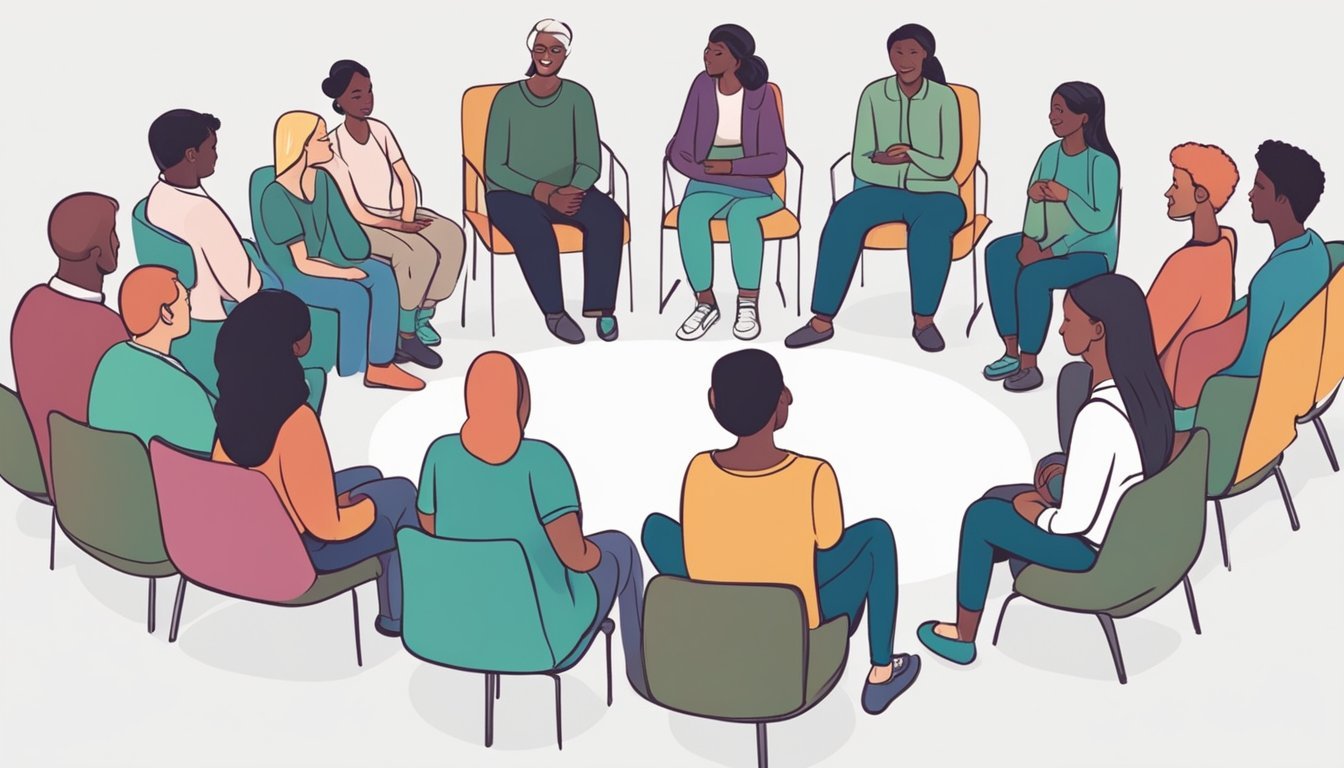Trauma and Recovery: The Psychological Journey of the Victims in American Nightmare
A Deep Dive into Post-Event Healing
Trauma leaves deep wounds that can haunt victims long after the initial event. For those affected by the American Nightmare incident, the psychological journey of recovery is both challenging and complex. Trauma and recovery are intricately linked, with survivors often experiencing symptoms of post-traumatic stress disorder (PTSD) that impact their daily lives and mental health.
The path to healing requires confronting painful memories and emotions. Victims may struggle with nightmares, flashbacks, and intense anxiety as they work through their traumatic experiences. Mental health professionals play a crucial role in guiding survivors through evidence-based treatments designed to process trauma and rebuild a sense of safety.
Recovery is not linear, and setbacks are common. However, with proper support and intervention, many trauma survivors are able to reclaim their lives and find new meaning. The journey underscores the resilience of the human spirit and the importance of compassionate care in the aftermath of devastating events.
Understanding Trauma and PTSD
Trauma and PTSD are complex psychological phenomena that can profoundly impact individuals. These conditions arise from exposure to distressing events and can lead to lasting emotional and behavioral changes.
Defining Trauma and Its Psychological Impact
Trauma refers to deeply distressing or disturbing experiences that overwhelm an individual's ability to cope. Traumatic events can include:
Natural disasters
Violent attacks
Serious accidents
Abuse or neglect
The psychological impact of trauma varies from person to person. Common reactions include:
Intense fear or anxiety
Feelings of helplessness
Difficulty concentrating
Sleep disturbances
Emotional numbness
Trauma can alter brain function, particularly in areas related to stress response and memory processing. This can lead to long-lasting effects on mental health and daily functioning.
Exploring PTSD and DSM-5 Criteria
Post-Traumatic Stress Disorder (PTSD) is a specific mental health condition that can develop after exposure to trauma. The DSM-5 outlines criteria for diagnosing PTSD:
Exposure to actual or threatened death, serious injury, or sexual violence
Intrusion symptoms (e.g., flashbacks, nightmares)
Avoidance of trauma-related stimuli
Negative alterations in cognition and mood
Changes in arousal and reactivity
Symptoms must persist for more than one month and cause significant distress or impairment in functioning. PTSD can manifest differently in adults and children, with age-specific criteria included in the DSM-5.
The Prevalence and Types of Traumatic Disorders
Traumatic disorders affect a significant portion of the population. Studies estimate that:
70% of adults experience at least one traumatic event in their lifetime
6% of the U.S. population will have PTSD at some point in their lives
Types of traumatic disorders include:
Acute Stress Disorder
PTSD
Complex PTSD
Adjustment Disorders
Each type has unique characteristics and treatment approaches. Factors such as the nature of the trauma, individual resilience, and support systems influence the development and severity of these disorders.
Early intervention and appropriate treatment can significantly improve outcomes for those affected by traumatic disorders.
Symptoms and Diagnosis of PTSD
Post-Traumatic Stress Disorder (PTSD) manifests through a range of symptoms that significantly impact daily functioning. These symptoms include intrusive memories, avoidance behaviors, and alterations in mood and reactivity.
Identifying PTSD Symptoms and Their Severity
PTSD symptoms typically emerge within three months of a traumatic event, though they can appear later. Key indicators include:
Intrusive thoughts or memories of the trauma
Intense distress when exposed to trauma-related cues
Persistent avoidance of trauma-related stimuli
Negative changes in thoughts and mood
Heightened arousal and reactivity
Symptom severity varies among individuals. Some may experience mild distress, while others face debilitating effects that disrupt work, relationships, and daily activities.
Healthcare professionals use standardized assessment tools to evaluate symptom severity and functional impairment. These assessments help guide treatment planning and monitor progress over time.
Nightmares and Re-experiencing in PTSD
Re-experiencing symptoms, particularly nightmares, are hallmark features of PTSD. These symptoms include:
Recurrent, involuntary, and intrusive distressing memories
Traumatic nightmares
Flashbacks or dissociative reactions
Intense psychological distress at exposure to trauma-related cues
Nightmares in PTSD often replicate the traumatic event or incorporate themes of danger and helplessness. They can lead to sleep disturbances, affecting overall functioning and quality of life.
Re-experiencing symptoms can be triggered by internal or external cues related to the trauma. These intrusive experiences feel vivid and often evoke strong emotional and physical reactions.
Assessing PTSD Symptom Severity and Impact
Clinicians use various methods to assess PTSD symptom severity:
Structured clinical interviews
Self-report questionnaires
Behavioral observations
These assessments evaluate the frequency, intensity, and duration of symptoms. They also gauge the impact on social, occupational, and personal functioning.
Key areas of assessment include:
Emotional numbing and avoidance behaviors
Hyperarousal symptoms (e.g., irritability, hypervigilance)
Changes in cognition and mood
Functional impairment in daily life
Accurate assessment is crucial for diagnosis and treatment planning. It helps clinicians tailor interventions to address specific symptom clusters and monitor treatment effectiveness over time.
Historical Perspective of Trauma
Trauma has profoundly impacted individuals and societies throughout history. Perspectives on trauma have evolved significantly, particularly in relation to forgotten historical events and combat experiences.
Trauma in the Context of forgotten history
Unacknowledged historical events can inflict deep psychological wounds on communities. Indigenous populations have faced intergenerational trauma from colonization and cultural suppression. The effects persist long after the initial events, shaping identities and relationships.
Recent research examines how past injustices continue to impact mental health. Recognizing these forgotten traumas is crucial for healing. Some communities have initiated traditional healing practices to address historical wounds.
Efforts to document and validate these experiences help survivors process their pain. Public acknowledgment of past harms can foster reconciliation and recovery.
Combat Veterans and PTSD: The Vietnam War
The Vietnam War marked a turning point in understanding combat-related trauma. Prior to Vietnam, breakdowns were often attributed to personal weakness. The war's impact on veterans challenged this view.
Many soldiers returned with severe psychological symptoms. Flashbacks, nightmares, and hypervigilance plagued numerous veterans. These experiences led to the formal recognition of Post-Traumatic Stress Disorder (PTSD) in 1980.
Vietnam highlighted the need for better mental health support for veterans. It sparked research into trauma's long-term effects. Treatment approaches evolved to address the unique needs of combat survivors.
The war's legacy continues to shape trauma care and veterans' services today.
Trauma-Induced Sleep Disturbances
Trauma survivors often experience significant sleep disturbances that can profoundly impact their recovery and daily functioning. These sleep issues frequently manifest as nightmares, insomnia, and alterations in sleep patterns.
The Relationship Between Trauma and Sleep Disorders
Trauma and sleep disorders are closely intertwined. Up to 90% of individuals with posttraumatic stress disorder (PTSD) report some form of sleep problem. Sleep disturbances can persist long after the traumatic event and may even predict the development of PTSD.
Insomnia is a common complaint among trauma survivors. Many struggle to fall asleep or maintain sleep throughout the night. This can lead to daytime fatigue, irritability, and difficulty concentrating.
Hyperarousal, a key symptom of PTSD, can make it challenging for individuals to relax and enter a restful state. This heightened alertness often disrupts normal sleep-wake cycles.
Nightmare Characteristics and Frequency
Trauma-related nightmares differ significantly from typical dreams. They tend to be more vivid, distressing, and realistic. These nightmares often replicate aspects of the traumatic event or evoke similar emotions.
Unlike regular dreams, trauma-induced nightmares can occur during both rapid eye movement (REM) and non-REM sleep stages. This unusual pattern distinguishes them from other types of nightmares.
The frequency of nightmares varies among trauma survivors. Some may experience them nightly, while others have them less frequently. Nightmare frequency often correlates with the severity of PTSD symptoms.
Impact of Trauma-Based Nightmares on Sleep Quality
Trauma-based nightmares significantly disrupt sleep continuity. Survivors may awaken abruptly, feeling distressed and unable to return to sleep. This fragmented sleep pattern can lead to chronic sleep deprivation.
The fear of experiencing nightmares can create a negative cycle. Some individuals may resist sleep or use unhealthy coping mechanisms to avoid nightmares, further compromising their sleep quality.
Physiological changes often accompany trauma-related nightmares. Increases in heart rate and respiratory rate can lead to sudden awakenings, leaving the individual feeling anxious and on edge.
Poor sleep quality resulting from nightmares can exacerbate daytime PTSD symptoms. This creates a bidirectional relationship where sleep problems and trauma symptoms reinforce each other.
Pathways to Recovery
Trauma survivors can find healing through multiple avenues. These paths often involve structured stages, therapeutic support, and reintegration into society.
Stages of Recovery and Mastery Over Trauma
Recovery from trauma typically progresses through identifiable stages. The initial phase focuses on establishing safety and stability. Survivors work to regain a sense of security in their environment and relationships.
The middle stage involves remembrance and mourning. Survivors process traumatic memories and grieve losses associated with their experiences. This can be an emotionally challenging period but is crucial for healing.
The final stage centers on reconnection and creating a new sense of self. Survivors develop new coping skills, rebuild relationships, and redefine their place in the world. This stage marks significant progress in mastering the impact of trauma.
The Role of Psychotherapy in Recovery
Psychotherapy plays a vital role in trauma recovery. Cognitive-behavioral therapy (CBT) helps survivors identify and change unhelpful thought patterns and behaviors linked to their trauma.
Eye Movement Desensitization and Reprocessing (EMDR) is another effective treatment. It helps process traumatic memories and reduce their emotional impact.
Group therapy provides a supportive environment where survivors can share experiences and learn from others. This can reduce feelings of isolation and shame often associated with trauma.
Integration of Trauma Survivor Into Society
Reintegration into society is a critical aspect of recovery. Survivors often benefit from gradual exposure to social situations, starting with safe and supportive environments.
Building a support network is essential. This may include family, friends, support groups, or community organizations that understand trauma recovery.
Engaging in meaningful activities, such as work or volunteer opportunities, can help survivors regain a sense of purpose and connection to their community. These experiences contribute to rebuilding self-esteem and confidence.
Therapeutic Interventions
Effective treatments for trauma-related nightmares combine psychological and behavioral approaches. These interventions aim to process traumatic memories, reduce nightmare frequency, and improve overall well-being.
Prolonged Exposure Therapy and Cognitive Processing Therapy
Prolonged Exposure Therapy (PE) helps victims confront trauma-related memories and situations. It involves repeated exposure to traumatic memories in a safe environment. This process reduces fear and anxiety associated with these memories.
Cognitive Processing Therapy (CPT) focuses on challenging and modifying unhelpful thoughts related to the trauma. It helps victims develop more balanced perspectives about their experiences.
Both PE and CPT are evidence-based treatments for PTSD. They have shown significant effectiveness in reducing nightmare frequency and severity.
Imagery Rehearsal Therapy (IRT) and Nightmare Rescripting
IRT is a specialized technique for addressing recurrent nightmares. Patients learn to rewrite their nightmares into less distressing scenarios. They then mentally rehearse these new versions while awake.
Nightmare rescripting involves changing specific elements of recurring nightmares. This can include altering the ending or introducing empowering elements.
These techniques give victims a sense of control over their dreams. Studies show IRT can reduce nightmare frequency by up to 50% in some cases.
Holistic Approaches: Sleep Hygiene and Self-Care
Good sleep hygiene practices are crucial for nightmare management. This includes maintaining a consistent sleep schedule and creating a relaxing bedtime routine.
Self-care strategies like regular exercise, stress reduction techniques, and healthy eating habits support overall recovery. Mindfulness and relaxation exercises can help manage anxiety and improve sleep quality.
Limiting caffeine and alcohol intake, especially before bedtime, can also reduce nightmare frequency. Creating a comfortable sleep environment with minimal distractions promotes better sleep.
Support Systems and Professional Help
Recovery from trauma requires a multi-faceted approach involving professional help and strong support systems. These elements provide essential tools and resources for victims to navigate their healing journey.
Seeking Support From Mental Health Professionals
Mental health professionals play a crucial role in trauma recovery. Therapists trained in trauma-informed care offer specialized treatments like Cognitive Behavioral Therapy (CBT) and Eye Movement Desensitization and Reprocessing (EMDR). These evidence-based approaches help victims process traumatic experiences and develop coping strategies.
Psychiatrists may prescribe medications to manage symptoms of anxiety, depression, or PTSD when necessary. Regular therapy sessions provide a safe space for victims to express their feelings and work through complex emotions.
Support groups led by mental health professionals can also be beneficial. They allow victims to connect with others who have similar experiences, reducing feelings of isolation.
The Importance of Safety and Control in Recovery
Establishing a sense of safety and control is fundamental to trauma recovery. Mental health professionals help victims create safe environments and develop strategies to regain control over their lives.
This process may involve:
Identifying triggers and developing coping mechanisms
Setting boundaries in relationships
Creating safety plans for potential crisis situations
Empowering victims to make decisions about their treatment fosters a sense of agency. This approach helps counteract feelings of powerlessness often associated with traumatic experiences.
Psychoeducation for Patients and Families
Psychoeducation is a vital component of trauma recovery. It provides victims and their families with information about trauma, its effects, and the recovery process.
Key aspects of psychoeducation include:
Understanding common reactions to trauma
Recognizing symptoms of PTSD and other trauma-related disorders
Learning about effective coping strategies
Mental health professionals offer psychoeducation through individual sessions, group workshops, and educational materials. This knowledge helps normalize experiences and reduces stigma associated with trauma reactions.
Family members benefit from psychoeducation by learning how to support their loved ones effectively. It equips them with tools to create a supportive home environment conducive to healing.
Considerations for Special Populations
Trauma affects different groups uniquely, requiring tailored approaches to recovery. Childhood experiences and severe mental health conditions demand specialized care and interventions.
Childhood Trauma and Long-Term Mental Health
Childhood trauma can have profound effects on long-term mental health. Early adverse experiences often lead to complex trauma responses that persist into adulthood. Children exposed to traumatic events may struggle with emotional regulation, attachment issues, and cognitive development.
Treatment approaches for childhood trauma survivors focus on:
Building trust and safety
Developing healthy coping mechanisms
Addressing developmental delays
Enhancing family support systems
Therapies like play therapy and art therapy can help children process traumatic memories. Cognitive-behavioral therapy adapted for youth has shown effectiveness in reducing symptoms of post-traumatic stress disorder (PTSD).
Long-term support is crucial. Many adult survivors of childhood trauma benefit from ongoing therapy to manage persistent mental health challenges.
Addressing Suicidality and PTSD in Victims
Trauma victims face heightened risks of suicidality and PTSD. These conditions require immediate attention and specialized care. PTSD symptoms like flashbacks, hypervigilance, and avoidance can severely impact daily functioning.
Key interventions for suicidal trauma survivors include:
Crisis management plans
Safety planning
Intensive outpatient programs
Evidence-based treatments for PTSD in trauma victims:
Cognitive Processing Therapy
Prolonged Exposure Therapy
Eye Movement Desensitization and Reprocessing (EMDR)
Medication may be necessary to manage severe symptoms. Antidepressants and anti-anxiety medications can provide relief when combined with therapy.
Support groups offer valuable peer connections. Shared experiences can reduce isolation and promote healing among trauma survivors.
Advanced Topics in Trauma Research
Recent advances in trauma research have uncovered important connections between sensory experiences, sleep patterns, and cognitive processes in trauma recovery. These findings offer new insights for clinical interventions and treatment approaches.
The Clinical Relevance of Sensory Experiences in Trauma
Sensory experiences play a crucial role in trauma processing and recovery. Trauma often imprints itself through vivid sensory memories, which can be triggered by similar stimuli. Clinicians now recognize the importance of addressing these sensory aspects in therapy.
Techniques like sensory grounding help patients manage overwhelming sensations. This approach involves focusing on present-moment sensory input to anchor oneself in reality. Some therapists incorporate controlled sensory exposure to desensitize trauma survivors gradually.
Neurofeedback and biofeedback show promise in regulating sensory processing. These methods allow patients to observe and modify their physiological responses to traumatic triggers.
Rumination, REM Sleep, and PTSD
Research has revealed complex relationships between rumination, REM sleep, and Post-Traumatic Stress Disorder (PTSD). Rumination, the tendency to dwell on negative thoughts, often exacerbates PTSD symptoms.
Studies show that disrupted REM sleep patterns are common in PTSD patients. This disruption may interfere with the brain's natural process of consolidating and integrating traumatic memories. Improving sleep quality has become a key focus in PTSD treatment.
Cognitive Behavioral Therapy for Insomnia (CBT-I) has shown effectiveness in addressing sleep disturbances related to trauma. Some researchers are exploring targeted REM sleep enhancement techniques to aid trauma processing.
Mindfulness practices help reduce rumination by promoting present-focused awareness. These techniques complement traditional therapies in managing intrusive thoughts and improving overall well-being for trauma survivors.








